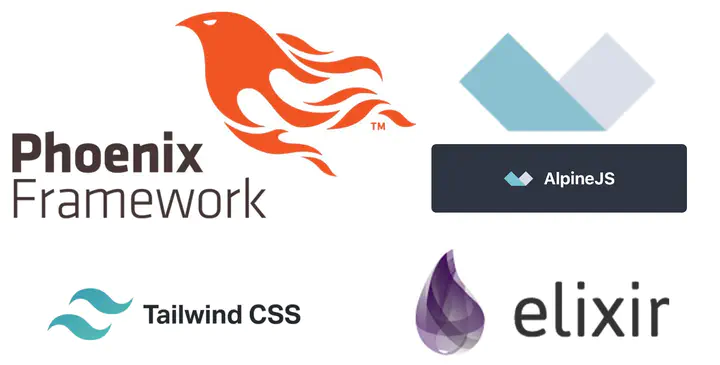Phoenix 1.5 PETAL Stack Setup - w/ asdf
Phoenix, Elixir, TailwindCSS, AlpineJS, LiveView - PETAL Stack

I have been enjoying the tools associated with Elixir and exploring the frontend. LiveView helps make that more intuitive and when that isn’t enough, AlpineJS is a lightweight JS tool with a similar syntax as Vue.
Install asdf - and required software
- https://thinkingelixir.com/install-elixir-using-asdf/
- https://www.cogini.com/blog/using-asdf-with-elixir-and-phoenix/
- https://carlyleec.medium.com/create-an-elixir-phoenix-app-with-asdf-e918649b4d58
On a Mac I used Homebrew:
brew install asdf
echo -e '\n. $(brew --prefix asdf)/asdf.sh' >> ~/.bash_profile
echo -e '\n. $(brew --prefix asdf)/etc/bash_completion.d/asdf.bash' >> ~/.bash_profile
source ~/.bash_profile # (or open a new terminal)
Now you can install asdf software packages:
asdf plugin-add erlang
asdf plugin-add elixir
asdf plugin-add nodejs
asdf plugin-add Postgres
Now you need to install the desired versions (usually the newest) - currently:
asdf list all erlang
asdf install erlang 23.3.1
# note the elixir version otp must match the erlang version!
asdf list all elixir
asdf install elixir 1.11.4-otp-23
# asdf install elixir 1.11.4-otp-24
# if you mismatch elixir with erlang you will get errors like:
# {"init terminating in do_boot",{undef,[{elixir,start_cli,[],[]},{init,start_em,1,[]},{init,do_boot,3,[]}]}}
asdf list all nodejs
asdf install nodejs lts-fermium
asdf list all Postgres
asdf install Postgres 13.2
Get the newest Phoenix Hex Package
Once you have established you have the requrements - the download the newest version of Phoenix (go to: https://hexdocs.pm/phoenix/installation.html#phoenix to see the newest version) - at the time of this writing its 1.5.8 - be sure its installed using:
mix archive.install hex phx_new 1.5.8
create / config a project
First we will creat the folder / project location
mkdir fenix
Now we will tell it which software to use:
touch fenix/.tool-versions
cat <<EOF >>fenix/.tool-versions
erlang 23.3.1
elixir 1.11.4-otp-23
Postgres 13.2
nodejs lts-Fermium
EOF
Create a new Phoenix Project
https://carlyleec.medium.com/create-an-elixir-phoenix-app-with-asdf-e918649b4d58
Now you can simply do:
mix phx.new fenix --live
cd fenix
mix ecto.create
mix phx.server
assuming all is good lets configure git:
git init
git add .
git commit -m "initial Phoneix install with LiveView"
install & test Alpine JS
https://underjord.io/getting-started-with-petal.html https://dockyard.com/blog/2020/12/21/optimizing-user-experience-with-liveview
cd assets
npm install alpinejs
Now change app.js is to require our new setup:
# assets/js/app.js
// .. after the app.scss import add:
import Alpine from "alpinejs";
still in assets/js/app.js find: let liveSocket = new LiveSocket("/live", Socket, {params: {_csrf_token: csrfToken}})`
and change to:
let liveSocket =
new LiveSocket("/live",
Socket,
{ params: {_csrf_token: csrfToken},
dom: {
onBeforeElUpdated(from, to){
if(from.__x){ Alpine.clone(from.__x, to) }
}
} }
)
TEST by adding to the end of: lib/fenix_web/live/page_live.html.leex
<section>
<h2>Alpine JS Installed</h2>
<div x-data="{name:''}">
<label for="name">Name:</label>
<input id="name" type="text" x-model="name" />
<p><br><b><em>Output:</em></b> <span x-text="name"></p>
</div>
</section>
test with:
mix phx.server
when typing the name should appear below!
let’s snapshot:
git add .
git commit -m "phoenix with alpine js"
Integrating Tailwind into phoenix
https://pragmaticstudio.com/tutorials/adding-tailwind-css-to-phoenix https://fullstackphoenix.com/tutorials/get-started-with-tailwind-in-phoenix
This source gives several options - here we install with postcss-import (for components from the beginning):
cd assets
npm install tailwindcss postcss autoprefixer postcss-loader@4.2 postcss-import --save-dev
touch postcss.config.js
cat <<EOF > postcss.config.js
module.exports = {
plugins: {
"postcss-import": {},
tailwindcss: {},
autoprefixer: {}
}
}
EOF
now open: assets/webpack.config.js and find:
{
test: /\.[s]?css$/,
use: [
MiniCssExtractPlugin.loader,
'css-loader',
'sass-loader',
],
}
change too (add 'postcss-loader' between 'css-loader' & 'sass-loader'):
{
test: /\.[s]?css$/,
use: [
MiniCssExtractPlugin.loader,
'css-loader',
'postcss-loader',
'sass-loader',
],
}
now initialize tailwind config with:
npx tailwindcss init
this creates the file tailwind.config.js we will replace the purge: [], section with:
purge: [
'../lib/**/*.ex',
'../lib/**/*.leex',
'../lib/**/*.eex',
'./js/**/*.js'
],
Now the fill will look like:
module.exports = {
purge: [
'../lib/**/*.ex',
'../lib/**/*.leex',
'../lib/**/*.eex',
'./js/**/*.js'
],
darkMode: false, // or 'media' or 'class'
theme: {
extend: {},
},
variants: {
extend: {},
},
plugins: [],
}
now in assets/package.json find:
"scripts": {
"deploy": "webpack --mode production",
"watch": "webpack --mode development --watch"
},
and change this to:
"scripts": {
"deploy": "NODE_ENV=production webpack --mode production",
"watch": "webpack --mode development --watch"
},
we will create a file for our custom styles the assets/css/custom-style.css file:
# assuming you are still in the assets directory on the cli
touch css/custom-styles.css
Let’s also create our a custom component (we will make buttons for a counter to be sure tailwind and aplineJS are playing well together):
# assuming you are still in the assets directory on the cli
mkdir css/components
touch css/components/buttons.css
cat <<EOF > css/components/buttons.css
@layer components {
.btn-redish {
@apply bg-red-300 hover:bg-red-600 text-blue-800 font-bold py-2 px-4 rounded;
}
.btn-greenish {
@apply bg-green-300 hover:bg-green-600 text-blue-800 font-bold py-2 px-4 rounded;
}
}
EOF
Now will will configure Phoenix to load Tailwind, our custom-styles and our custom-components – DO THIS AT THE TOP OF the file assets/css/app.scss (@imports must be before all else):
/* Import tailwind - with postcss-import installed */
@import "tailwindcss/base";
@import "tailwindcss/components";
@import "tailwindcss/utilities";
/* custom styles - put after base imports! */
@import "./custom-styles.css";
/* import custom components */
@import "./components/buttons.css";
/* default phoenix styles - eventually remove */
@import "./phoenix.css";
add a test html from tailwind to the end of: lib/fenix_web/live/page_live.html.leex
<section class="grid grid-cols-1 gap-4">
<div>
<h2 class="text-red-500 text-5xl font-bold text-center">Tailwind CSS with AlpineJS</h2>
<p class="mt-5 font-bold text-center">Red Title with Colored Counter Buttons</p>
</div>
<div class="mt-10 flex justify-center" x-data="{ count: 0 }">
<button class="btn-redish" x-on:click="count--">Decrement</button>
<code>count: </code><code x-text="count"></code>
<button class="btn-greenish" x-on:click="count++">Increment</button>
</div>
</section>
Now when we start the server with mix phx.server we should have a centered / red title and colored buttons on our counter.
now lets snapshot our PETAL setup:
git add .
git commit -m "Tailwind installed"
Resources
- https://www.youtube.com/watch?v=o4Prej0wIZA
- http://blog.pthompson.org/alpine-js-and-liveview
- https://pragmaticstudio.com/tutorials/adding-tailwind-css-to-phoenix
- https://fullstackphoenix.com/tutorials/get-started-with-tailwind-in-phoenix
- https://fullstackphoenix.com/tutorials/combine-phoenix-liveview-with-alpine-js
- https://medium.com/mindvalley-technology/how-to-add-tailwindcss-to-your-phoenix-project-e2250ad31ace
- https://thinkingelixir.com/podcast-episodes/021-tailwind-css-alpine-js-and-liveview-with-patrick-thompson/